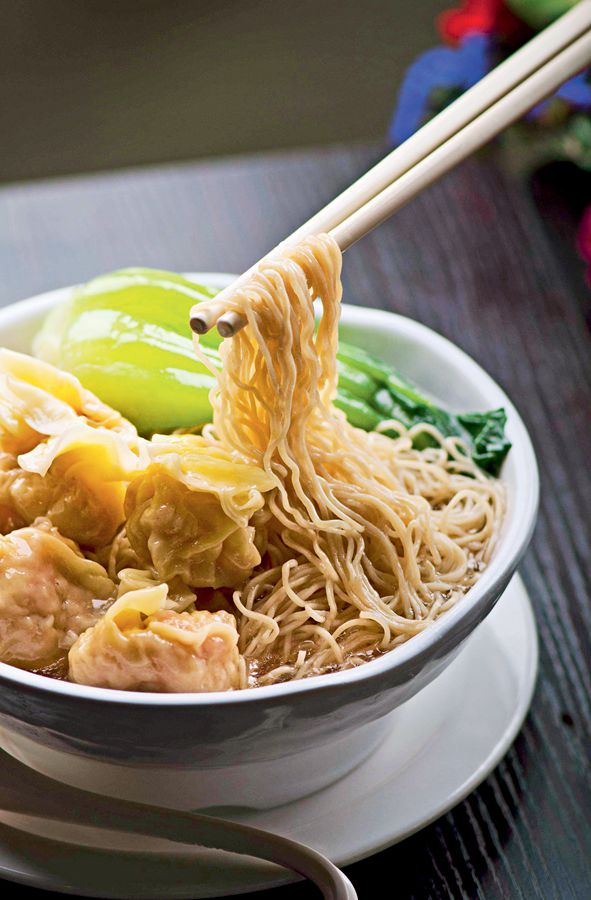IT is a common notion that Cantonese seldom make noodles because the climate of southern China’s Guangdong Province is unsuitable for growing high-quality wheat. But along with the exchanges and integration between northern and southern food in China, Cantonese have mastered their own way of making jook-sing noodles, or bamboo pressed noodles, ingredients for a variety of local specialties like wonton noodles, shrimp noodles, longevity noodles and Teochew-style sweet and sour fried noodles.

Jook-sing wonton noodles.
Just like the long rolling pin is an important utensil to make a type of thick, springy pasta in north China, for a Cantonese noodle master, a bamboo pole is also a must. Early in the Republic of China (1912-1949), the noodle-making utensils and ingredients in south China were improved on from the northern techniques. The jook-sing noodles then came into being and became popular in the Xiguan area of old Guangzhou.
Jook-sing noodles are made from duck eggs, flour and alkaline water. What makes these noodles special is the use of a bamboo pole to complete the production process. The chef usually straddles a long bamboo pole to press and beat the dough. Through the process, the dough will develop much elasticity.
The most authentic jook-sing noodles can be found at the Bamboo Garden Noodle House on West Heping Road in Guangzhou. Gourmets from old Xiguan will never disappear with this tantalizing flavor. Xiguan, located in Liwan District of Guangzhou, is a delicacy landmark of Guangzhou, boasting hundreds of local specialties like double-skin milk, shrimp wonton noodles, salty pancake, sampan congee and the globally renowned Ronghua Mooncake.
The most popular jook-sing noodles are wonton noodles, which are served as soup noodles, boiled or strained. Originated in Guangzhou, it is typical in Guangdong cuisine, and can be commonly found in eateries and restaurants around China. Wrappers made from jook-sing dough are the best choice, and the stuffing usually contains shrimp, mushrooms and minced pork. The essential ingredient of the dish is the Cantonese bone broth. After simmering for three to six hours with pork bone, chicken bone, dried flatfish, and dried small shrimp, the broth has a rich seafood flavor, which is quite refreshing but not greasy.
According to ancient records, in the reign of Emperor Tongzhi (1861-1875) of the Qing Dynasty (1644-1911), wonton noodles were brought into Guangzhou by a Hunan resident, who started a Sanchu Noodle House on Beijing Road. After several improvements, the simple-made wonton became a popular street snack that has wrappers made from flour with eggs and stuffing with minced meat, shrimp and hotbed chives. Soon street peddlers who carry their wares suspended from a bamboo pole on their shoulders started to imitate the cooking and sold it while knocking bamboo clappers to attract diners.
Shrimp noodles, as the term suggests, are the noodles garnished with small shrimp and are eaten after being boiled and strained.
Yi Mian, or E-Fu Noodles, are often seen at Cantonese birthday banquets for the long noodles symbolize longevity. They were named after a chef who worked in the mansion of an official surnamed Yi. The egg-and-wheat noodles are deep-fried and thus can be preserved for a long time. When eaten, they are cooked in boiling water and then garnished with seasonings.
Sweet and sour fried noodles are typical in Teochew cuisine, which originated in the Chaoshan region in east Guangdong. To make these noodles, flour is mixed with duck egg yolks to make the dough, and then noodles are fried in oil till the color becomes golden. Then, hotbed chives, sugar and vinegar are added. The complete dish has a rich aroma of eggs and is not oily.
